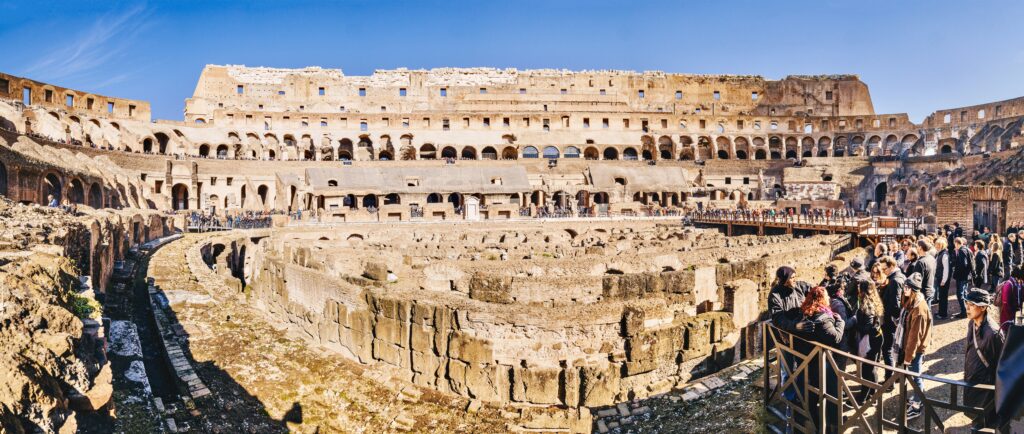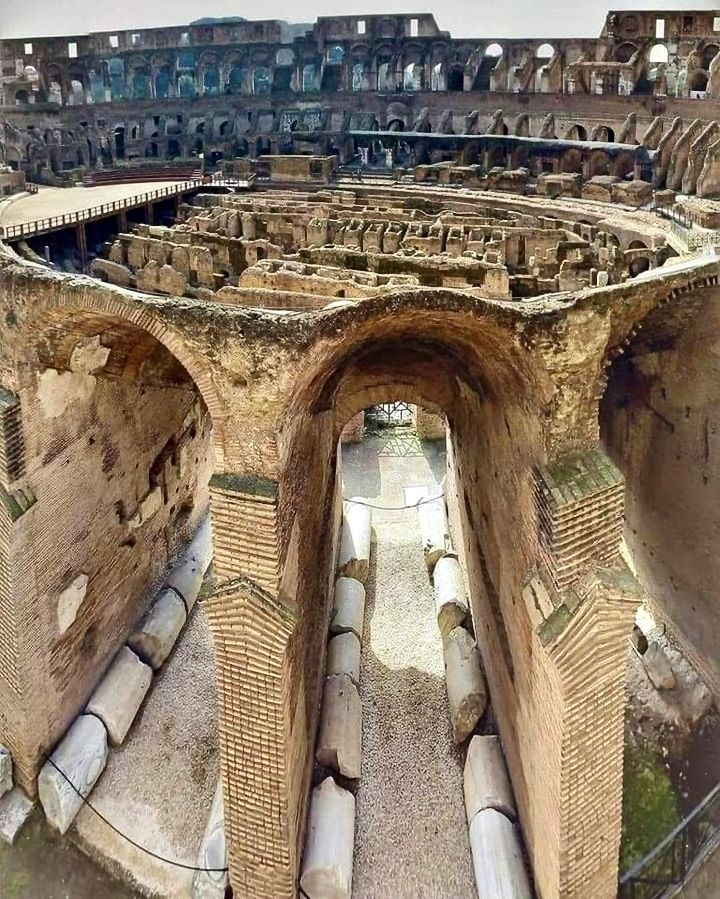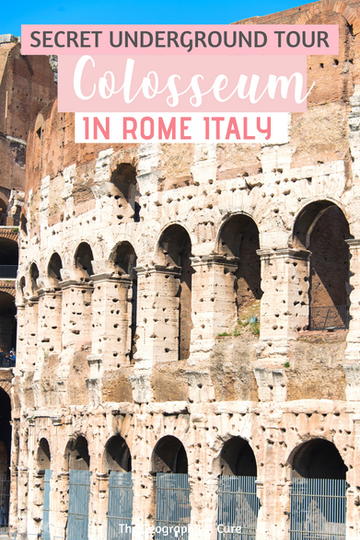“While stands the Coliseum, Rome shall stand; When falls the Coliseum, Rome shall fall; And when Rome falls – the World.” — Lord Byron
Every visitor to Rome visits the Colosseum. But most don’t make it into the fascinating underground area.
Formally named the Flavian Amphitheater, the Colosseum has stood in Rome for almost 2,000 years. It’s the most instantly recognizable monument from the classical world.
Despite the ravages of time, the Colosseum is an incredibly well-preserved piece of Rome’s fascinating history.
On this sojourn in Rome, I opted for a Colosseum underground tour. In the tour, visitors can access areas not open to standard ticket holders.
It’s like a backstage pass into the riotous Colosseum history. Plus, I loved having an actual archaeologist as a guide.
The Colosseum embodies ancient Rome, especially its lust for violence and entertainment. Killing became a spectator sport.
On the underground tour, you’re immersed in tales of gladiators, chariots, and wild beasties. Gladiators and every type of wild animal fought to the death in physical contests in this grand public arena.

What Is The Colosseum?
Emperor Vespasian initiated construction of the Colosseum in 72 AD, completed by his son Titus in 80 AD, with subsequent additions by Domitian, including the hypogeum.
Built on Nero’s Golden House site, it symbolized a shift in Roman architecture towards public structures under Vespasian’s rule.
The Colosseum served as a propaganda tool, showcasing Roman power and enhancing emperor prestige, while providing mass entertainment for up to 80,000 spectators.
Inside, innovative lightweight concrete enabled grand designs, featuring Greek columns and tiered seating with strict social segregation.
Games included gladiator duels, staged hunts, and executions, evolving to mythological re-enactments, but declined with the rise of Christianity.
Emperor Honorius banned gladiator contests in 407 AD, leading to sporadic closures until 523 AD, when the Colosseum ceased operations.
In the 18th century, preservation efforts began, prompted by its significance to Christianity, though much of it was lost to earthquakes and repurposing over the centuries.
What To See In The Underground Colosseum
1. The Arena Floor
Our tour began on the arena floor, also known as the “stage.” You enter the arena through the Gate of Death.
This was the gate that dead gladiators were brought through. A hallway leading to the seats was called the Vomitorium. When the games were over, the Colosseum would “vomit” out its spectators.
The games and spectacles took place in the oval shaped arena. Originally, the arena had a wooden floor, sprinkled with sand to absorb the blood.
There’s a bit of reconstructed floor to give you a sense of what it looked like. There’s also a reconstructed trap door, which was one of 36, from which the animals below were brought onto the stage.
You can’t help but feel small and insignificant standing on the edge of the arena floor. Before you are the massive ruins of the ancient world’s most impressive amphitheater.
You can imagine the emperor giving the thumbs up or thumbs down sign amid roaring crowds. Our guide told us that this did happen on occasion.
But, unlike in the movie Gladiator, the crowds likely didn’t have much say in thumb’s direction.
Nor did gladiators greet the emperor with the legendary phrase “We who are about to die salute you.”
2. The Basement, or Hypogeum, of the Colosseum
Next, we headed to the area which gives the tour its name – the Colosseum’s underground basement, the hypogeum.
Until the 19th century, the hypogeum was buried under 40 feet of earth, its existence obliterated.
In 1813 and 1874, attempted archaeological excavations were thwarted by flooding groundwater. Finally, as part of Benito Mussolini’s glorification of classical Rome, workers excavated and cleared the hypogeum.
The hypogeum was the underground staging area for the games. It was an elaborate network of tunnels, cages, and holding rooms beneath the arena floor. Slaves, prisoners, animals, and gladiators were kept there before their “performances.”
Set pieces and scenes for a performance were also stored there too. Man made machines — ramps, cranes, and lifts — hoisted them up to the arena floor.
With the arena floor long gone, most of the hypogeum is completely exposed. Grass grows where tunnels and cages once were. However, much of the underground structure around the outer rim of the arena is fairy well preserved. That’s the part you’ll tour.
Exploring this area gives you a behind-the-scenes look at the intense preparation that went into producing the public spectacles.
You’ll stroll down the same central corridor that the gladiators once strode. You can see canals that were used to launch mock sea battles when the Colosseum was flooded and animal cages.
Parts of hypogeum are reconstructed, like the lifts and elevator shafts that once took the animals and gladiators up to the arena level, to make it easier to imagine how things operated down here.
It’s dark, but not nearly as black as it would’ve been 2,000 years ago when the arena floor was intact.
The hypogeum definitely wasn’t glamorous. It was dark and smelly, with little air circulation. According to the Smithsonian, the hypogeum:
was as hot as a boiler room in the summer, humid and cold in winter, and filled all year round with strong smells, from the smoke, the sweating workmen packed in the narrow corridors, the reek of the wild animals … The noise was overwhelming — creaking machinery, people shouting and animals growling, the signals made by organs, horns or drums to coordinate the complex series of tasks people had to carry out, and, of course, the din of the fighting going on just overhead, with the roaring crowd.
3. The Third Ring
The final stop on the Colosseum Underground Tour is the nosebleed seats.
After passing through a gated area on the second level of the Colosseum, you arrive at the Third Ring located at the top of the amphitheater. It’s the highest part of this UNESCO site.
This upper level provides a wide view of the Colosseum and the ruins in the Forum and Palatine Hill.
This is also one of the few spots where you can still see pieces of the original outer walls of the Colosseum. The rest were taken and sold after the fall of Rome.

How To Book An Underground Colosseum Tour
The cheapest way to get an underground ticket is to book directly with the Colosseum. You’ll need to purchase two different tickets – a standard ticket (€16) and an underground tour ticket (€9). You can do this online here.
There’s a €2 online booking fee per ticket. But it’s worth it to secure your preferred tour time and avoid the long ticket lines.
You can’t visit the Colosseum anymore without a reservation. If you purchase your ticket at the onsite ticket office, your ticket is only good for the same day.
Alternatively, you can book a curated underground tour with a private tour company in Rome, which is what I did.
Though the tours are more expensive, you’ll skip the line and get a knowledgable tour guide.
Practical Guide & Tips for Visiting the Underground Colosseum
Address: Colosseum is Piazza del Colosseo, 1, 00184 Comune di Roma RM
Metro: Colosseo (Line B)
Pro tip: Tickets sell out far in advance. You should make your reservation as soon as you know your exact visit date.
I hoe you’ve enjoyed my guide to the underground Colosseum. You may enjoy these other Rome travel guides and resources:
- 8 ways to spend 1 day in Rome
- 2 day itinerary for Rome
- 3 day itinerary for Rome
- 4 day itinerary for Rome
- 5 day itinerary for Rome
- Hidden gems in Rome
- Best museums in Rome
- Archaeological sites in Rome
- Guide to Palatine Hill
- Guide to the Roman Forum
Pin it for later.

